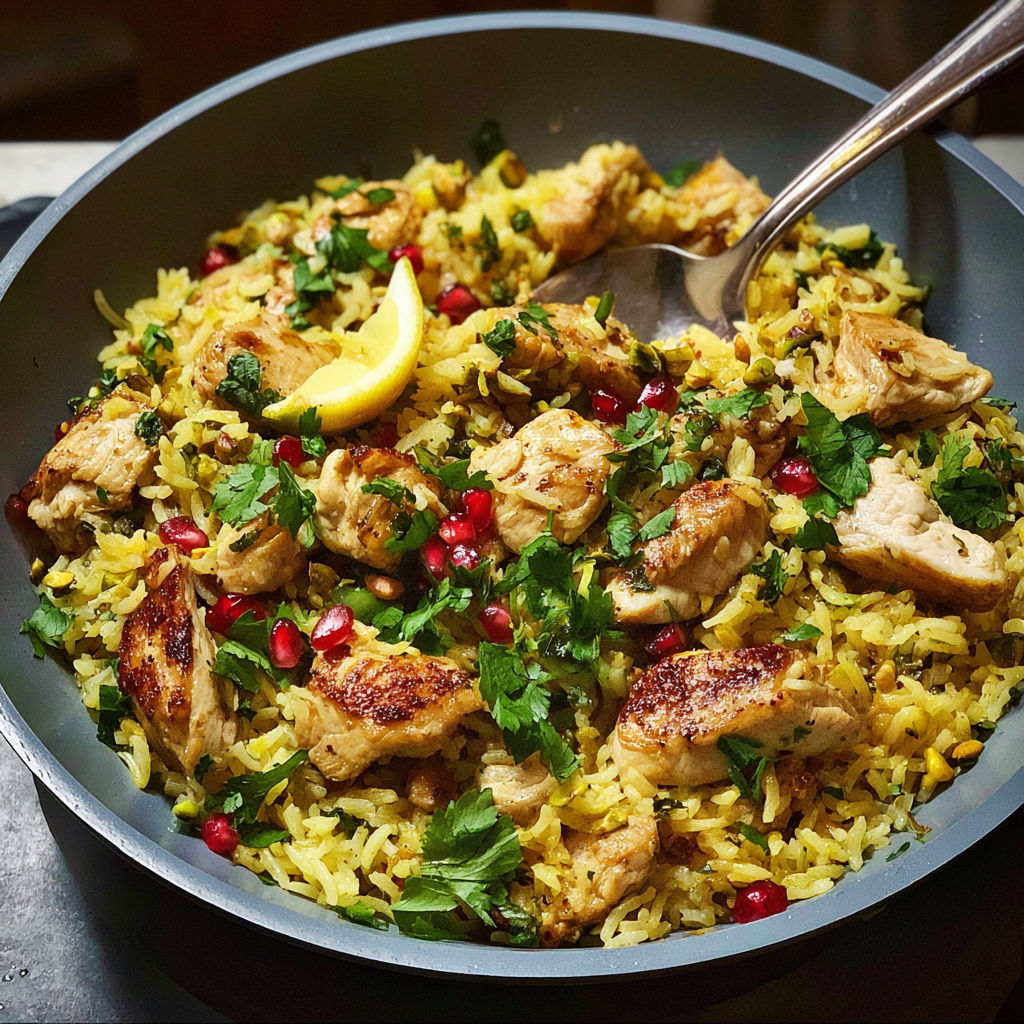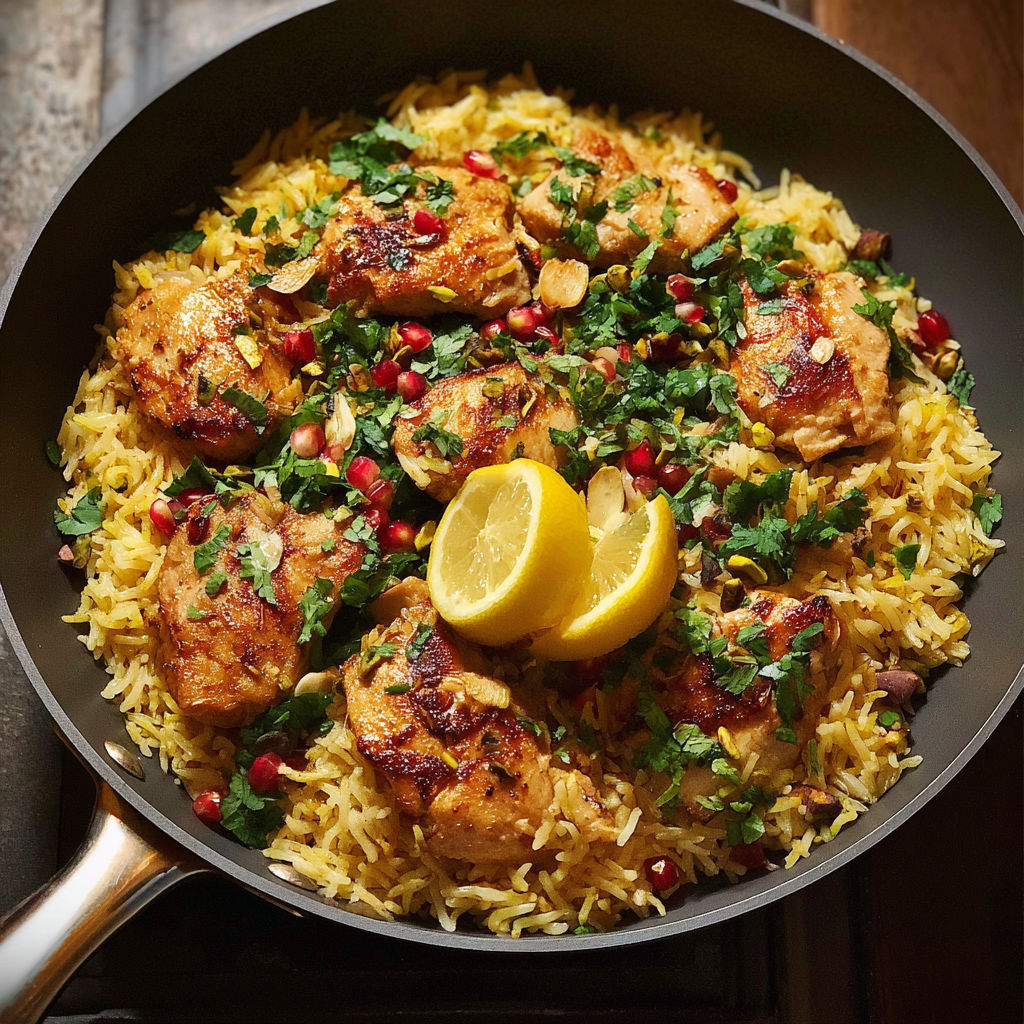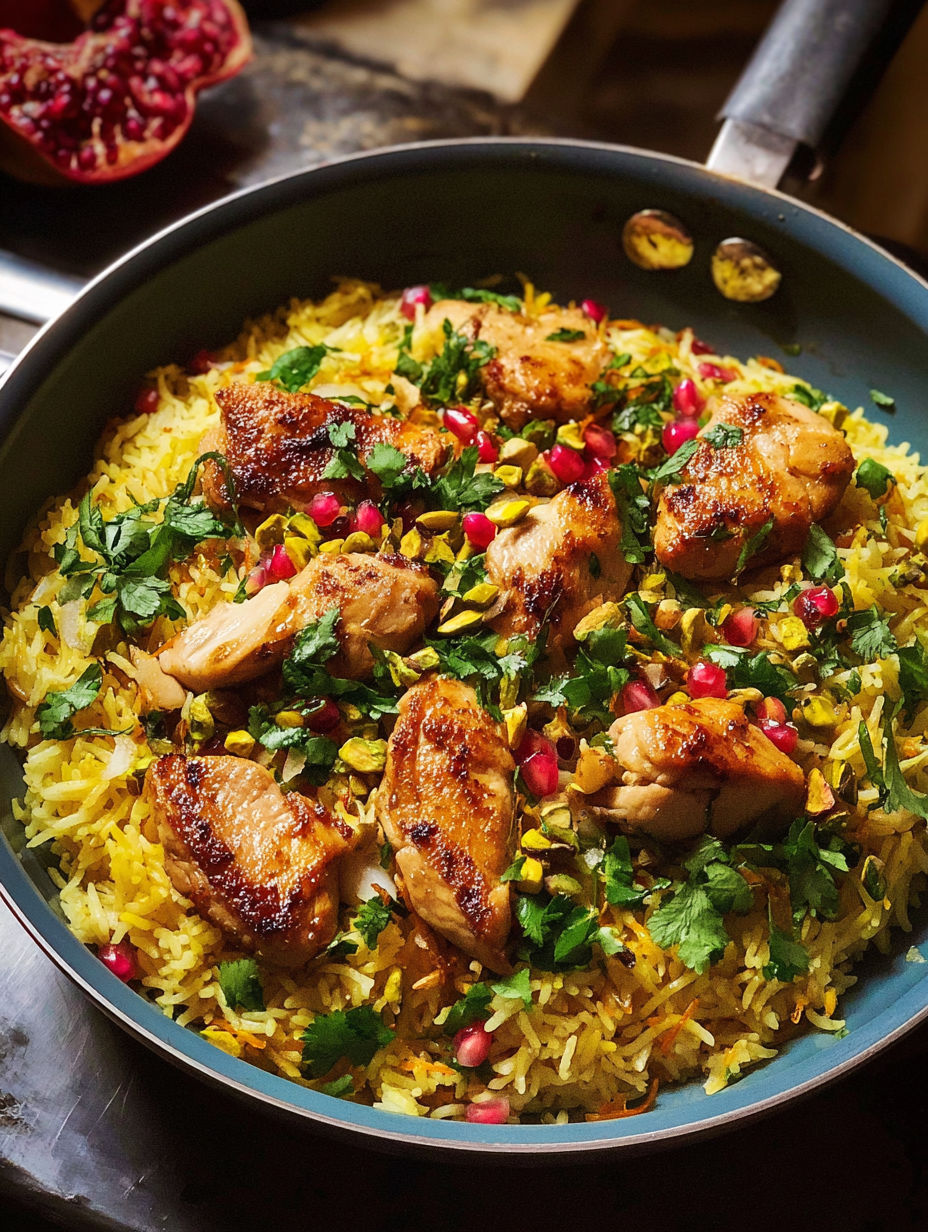 Pin
Pin
This fragrant Persian-Style Chicken Pilaf transports you to the spice markets of Iran with every aromatic bite. The combination of tender chicken, fluffy basmati rice, and jewel-like nuts creates a dish that's both comforting and exotic.
I first made this pilaf for my husband on our anniversary after we reminisced about our travels through the Middle East. The intoxicating aroma filling our kitchen immediately took us back to the bustling markets of Isfahan.
Ingredients
- Basmati rice the king of rice varieties with its distinctive fragrance and fluffy texture when cooked properly
- Ghee or unsalted butter provides a rich nutty foundation for authentic Persian flavor
- Onion and garlic essential aromatics that build the flavor base
- Cumin coriander cinnamon and turmeric the classic Persian spice blend that gives this dish its distinctive character
- Saffron threads the crown jewel of Persian cuisine adding subtle floral notes and gorgeous golden color
- Chicken thighs more flavorful and forgiving than breast meat staying tender throughout cooking
- Sultanas or golden raisins offer bursts of sweetness traditional in Persian rice dishes
- Almonds and pistachios provide contrasting texture and visual appeal while connecting to Persian culinary heritage
- Fresh herbs and pomegranate brighten the dish with color and fresh flavor
How To Make Persian-Style Chicken Pilaf
- Prepare the rice
- Rinse basmati rice thoroughly until water runs clear removing excess starch that would make rice sticky. Soak for exactly 20 minutes which hydrates the grains for even cooking and maximum fluffiness. This step is non-negotiable for authentic Persian rice.
- Build the flavor base
- Sauté onions in ghee over medium heat for about 5 minutes until translucent and softened but not browned. Add garlic and bloom the spices for 60 seconds until intensely fragrant being careful not to burn them. This aromatic foundation infuses the entire dish.
- Brown the chicken
- Add chicken pieces to the spice mixture and season generously. Cook for 4 to 5 minutes turning occasionally until pieces begin to develop golden edges. This partial cooking ensures the chicken will be perfectly tender when the rice is done.
- Combine and simmer
- Pour in stock and add rice saffron water and sultanas all at once. Bring to a gentle boil then immediately reduce to lowest heat setting. Cover with tight-fitting lid and simmer undisturbed for exactly 15 minutes. The steam trapped inside cooks everything perfectly.
- Rest and finish
- Remove from heat without peeking and allow to rest covered for 10 minutes. This crucial step allows moisture to distribute evenly throughout. Finally fluff gently with fork incorporating nuts and herbs. Serve immediately garnished with additional toppings.
My grandmother taught me that the secret to this dish is patience during the final resting period. She would slap my hand away if I tried to peek under the lid before time was up. That restraint results in perfectly fluffy individual grains of rice that are the hallmark of excellent Persian cooking.
Make-Ahead Options
This pilaf reheats beautifully making it perfect for entertaining. Prepare the entire dish up to two days ahead and refrigerate. When ready to serve reheat gently in a 325°F oven covered with foil with a few tablespoons of water sprinkled over top until heated through about 20 minutes. Add fresh herbs just before serving for brightest flavor and appearance.

Ingredient Substitutions
Traditional Persian pilaf is adaptable to what you have on hand. No saffron? While nothing truly replaces its unique flavor a pinch of turmeric will provide similar golden color. Chicken can be swapped for lamb beef or even hearty vegetables like eggplant and cauliflower for a vegetarian version. For a nutfree version substitute toasted pumpkin seeds for the traditional nuts. The authenticity comes from the cooking technique and spice profile rather than strict adherence to specific ingredients.
Cultural Context
Pilaf or polow is the cornerstone of Persian cuisine dating back thousands of years. In traditional Persian homes rice dishes are served at almost every important meal especially celebrations. The addition of fruits nuts and aromatic spices reflects Persias position as a historical crossroads of trade routes. Each region of Iran has its own variation of this classic dish with family recipes guarded and passed down through generations. Serving this dish is like offering a taste of Persian hospitality and cultural heritage.

Recipe FAQs
- → Can I make this Persian chicken pilaf in advance?
Yes, you can prepare the pilaf up to 2 days ahead. Cool completely before refrigerating, then reheat gently with a splash of water in a covered pot. Add the nuts and fresh herbs just before serving to maintain their texture and flavor.
- → What can I substitute for saffron?
While saffron provides the distinctive flavor and color, you can substitute with 1/4 teaspoon of turmeric for color and a pinch of cardamom for aroma. The flavor profile will be different but still delicious.
- → Is there a vegetarian version of this dish?
Absolutely! Replace the chicken with 2 cups of roasted vegetables like cauliflower, carrots, and eggplant. Use vegetable stock instead of chicken stock and follow the same cooking method.
- → How do I prevent the rice from becoming mushy?
The key is to rinse the rice thoroughly before cooking to remove excess starch, and don't skip the soaking step. Also, ensure you're using the correct liquid-to-rice ratio and avoid stirring during cooking.
- → What side dishes pair well with Persian chicken pilaf?
This pilaf works beautifully with a fresh cucumber yogurt salad (mast-o-khiar), a simple green salad with lemon dressing, or roasted vegetables. For a complete feast, add warm flatbread and pickled vegetables.
- → Can I use chicken breast instead of thighs?
Yes, you can substitute chicken breast, but be careful not to overcook it. Add the breast pieces later in the cooking process, about 5 minutes before adding the rice, to prevent them from becoming dry.
